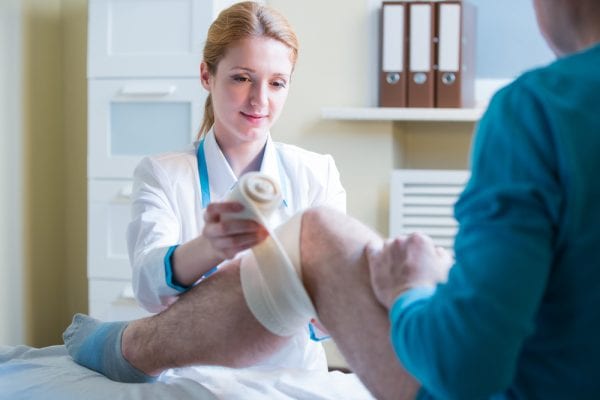
There is a great deal of confusion among joint pain sufferers about when to use heat and when to use cold therapies to bring relief. Temperature-inspired therapy is very simple, but often one of the most effective ways to alleviate the painful symptoms of joint pain that accompany arthritis.
This article offers a tutorial for when to use heat therapy and when to use cold therapy to address joint pain in various parts of the body.
When and How to Use Heat Therapy
Common forms of heat therapy are heating pads, hot showers, and warm baths.1,2,3 This type of therapy works on joint pain because it soothes tired muscles and stiff joints. Warmth is good for getting the body ready for exercise and getting the joints limber for activity. To warm up aching joints first thing in the morning, consider taking a hot shower.3 Or if joints are aching after long days of activity, soaking in a hot whirlpool can feel very relieving.1,3
Heating pads are effective if pain is localized in one particular area, as long as the skin is protected with a cloth buffer.2 For joint pain of the hands and feet, it may also help to try a warm paraffin wax4 treatment. Overall, heat treatments are long-term treatments that bring soothing relief when needed.
When and How to Use Cold Therapy
In contrast to heat therapy, cold therapy is best for acute joint pain.2 This is because cold temperatures dull pain by numbing nerve endings. Cold packs can also help to restrict blood vessels and slow down the flow of blood circulation, thereby reducing swelling. That’s why cold packs are typically used after an injury is sustained.
Individuals with joint pain should use cold treatments for no more than 20 minutes at a time to numb acute pain that comes on suddenly. Gel cold packs are sold commercially, but a bag of frozen peas offers a similar cooling effect.
Physicians often recommend cold therapy for people who suffer from gout; however, those with osteoarthritis can benefit from both types of therapy.5 One idea is to alternate between heat therapies and cold therapies throughout the day.6 For example, someone with osteoarthritis may use heat therapy first thing in the morning to warm up the joints and then cold therapy after exercise to reduce swelling that occurs.
Other At-Home Remedies for Joint Pain
The bottom line is that ice is meant for injuries and dulling acute pain, while heat is better for chronic pain and ongoing management. While severe and prolonged joint pain often requires professional medical attention and ongoing monitoring, mild and sporadic pain can sometimes be managed with at-home remedies.
For example, over-the-counter pain relief creams like JointFlex can deliver quick, effective, and highly concentrated pain relievers right to the pain source. Other home remedies that some joint pain sufferers swear by include blackstrap molasses, turmeric, magnesium, fenugreek, and apple cider vinegar.7,8 Massage, acupuncture, and gentle yoga poses and stretches may also help to alleviate pain and promote an active lifestyle without prescription medications or surgery.9,10,11
REFERENCES FOR USING HEAT AND COLD THERAPIES FOR JOINT PAIN
1. Use your tub to fight joint pain and stiffness. Arthritis Today Magazine. Retrieved November 2, 2018 from http://blog.arthritis.org/living-with-arthritis/warm-water-therapy-joint-pain/.
2. Using heat and cold for pain relief. Arthritis Foundation. Retrieved November 2, 2018 from https://www.arthritis.org/living-with-arthritis/treatments/natural/other-therapies/heat-cold-pain-relief.php.
3. Warming techniques to relieve rheumatoid arthritis pain. Arthritis Foundation. Retrieved November 2, 2018 from https://www.arthritis.org/living-with-arthritis/pain-management/tips/warming-techniques-rheumatoid-arthritis-pain.php.
4. Millard, J. B. & Harris, R. (1955). Pariffin-wax baths in the treatment of rheumatoid arthritis. Annals of the Rheumatic Diseases, 14, 278-282. Retrieved November 2, 2018 from https://ard.bmj.com/content/annrheumdis/14/3/278.full.pdf.
5. Schlesinger, N. (2006 December). Response to application of ice may help differentiate between gouty arthritis and other inflammatory arthritides. Journal of Clinical Rheumatology, 12, 275-276. Retrieved November 2, 2018 from National Center of Biotechnology Information https://www.ncbi.nlm.nih.gov/pubmed/17149056.
6. Kambach, B. J. (2015 August 21). Applying heat vs. cold to an arthritic joint. Arthritis Health. Retrieved November 2, 2018 from https://www.arthritis-health.com/treatment/alternative-treatments/applying-heat-vs-cold-arthritic-joint.
7. Orenstein, B. W. The best foods to add to your diet to fight rheumatoid arthritis. Everyday Health. Retrieved November 1, 2018 from https://www.everydayhealth.com/hs/rheumatoid-arthritis-treatment-management/foods/.
8. Pundarikakshudu, K, Shah, D. H., Panchal, A. H., & Bhavsar, G. C. (2016 July-August). Anti-inflammatory activity of fenugreek (Trigonella foenum-graecum Linn) seed petroleum ether extract. Indian Journal of Pharmacology, 48, 441-444. Retrieved November 2, 2018 from National Center of Biotechnology Information https://www.ncbi.nlm.nih.gov/pmc/articles/PMC4980935/.
9. Bernstein, S. Types of massages. Arthritis Foundation. Retrieved November 1, 2018 from https://www.arthritis.org/living-with-arthritis/treatments/natural/other-therapies/massage/massage-types.php.
10. Foltz-Gray, D. Fight arthritis pain without pills. Arthritis Foundation. Retrieved November 2, 2018 from https://www.arthritis.org/living-with-arthritis/pain-management/tips/arthritis-pain-relief-alternatives.php.
11. Moonaz, S. Yoga poses for arthritis patients from Johns Hopkins. Johns Hopkins Arthritis Center. Retrieved November 1, 2018 from https://www.hopkinsarthritis.org/patient-corner/disease-management/yoga-poses-for-arthritis-patients-from-johns-hopkins/.
